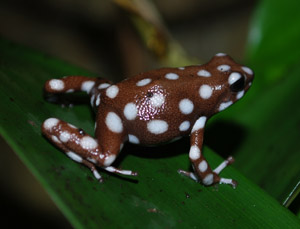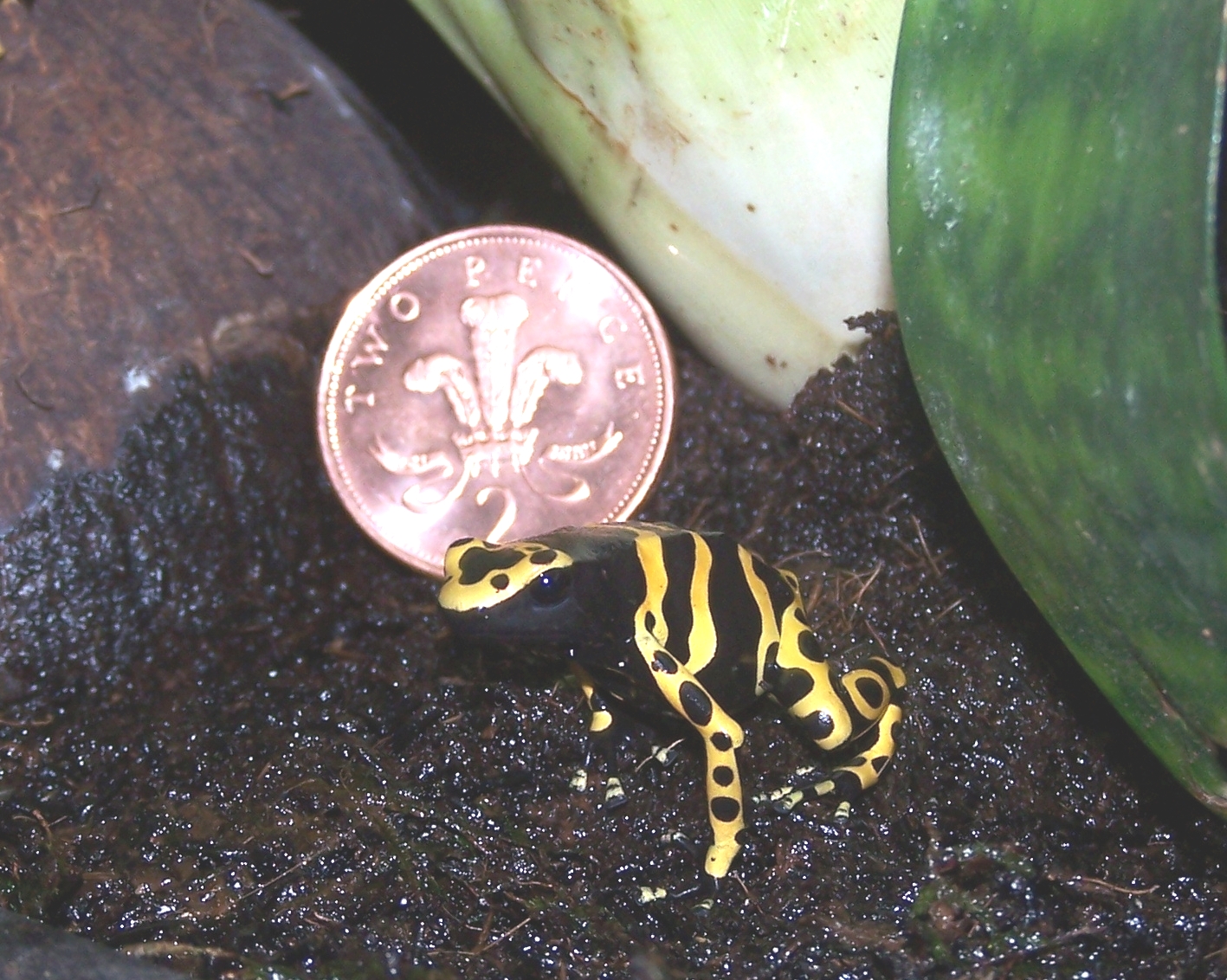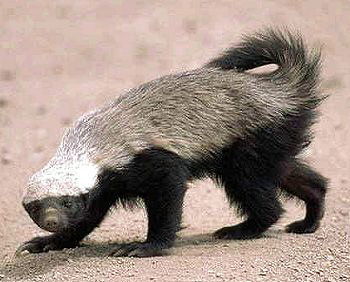|
Dendrobatidae
Poison dart frog (also known as dart-poison frog, poison frog or formerly known as poison arrow frog) is the common name of a group of frogs in the Family (biology), family Dendrobatidae which are native to tropical Central and South America. These species are Diurnality, diurnal and often have brightly colored bodies. This bright coloration is correlated with the toxicity of the species, making them Aposematism, aposematic. Some species of the family Dendrobatidae exhibit extremely bright coloration along with high toxicity, while others have Crypsis, cryptic coloration with minimal to no amount of observed toxicity. The species that have great toxicity derive this feature from their diet of ants, mites and termites. However, other species that exhibit cryptic coloration, and low to no amounts of toxicity, eat a much larger variety of prey. Many species of this family are Threatened species, threatened due to human infrastructure encroaching on their habitats. These amphibians ... [...More Info...] [...Related Items...] OR: [Wikipedia] [Google] [Baidu] |
Ameerega
''Ameerega'' is a genus of poison dart frogs in the family Dendrobatidae. These frogs live around rocks that are nearby streams. They are found in central South America north to Panama. It contains many former species of the genus ''Epipedobates''. Species The following species are recognised in the genus ''Ameerega'': References Ameerega, Poison dart frogs Amphibians of Central America Amphibians of South America Amphibian genera {{Dendrobatidae-stub ... [...More Info...] [...Related Items...] OR: [Wikipedia] [Google] [Baidu] |
Epipedobates
''Epipedobates'' is a genus of poison dart frogs native to northern South America (Colombia and Ecuador) west of the Andes, including the western slopes. Common name phantasmal poison frogs has been suggested for the genus. Taxonomy ''Epipedobates'' was erected in 1987 in an attempt to split dendrobatids into monophyletic genera, accommodating species that had until then been placed in ''Phyllobates''. In the major revision of poison dart frogs in 2006, most of the species formerly placed in ''Epipedobates'' were then transferred to ''Ameerega'', leaving behind just five species. With description of new species, the species count had increased to seven by early 2015. Description Dorsal Dorsal (from Latin ''dorsum'' ‘back’) may refer to: * Dorsal (anatomy), an anatomical term of location referring to the back or upper side of an organism or parts of an organism * Dorsal, positioned on top of an aircraft's fuselage * Dorsal c ... colouration is cryptic, brown. A pale oblique ... [...More Info...] [...Related Items...] OR: [Wikipedia] [Google] [Baidu] |
Ranitomeya
''Ranitomeya'' is a genus of dart poison frogs found in Panama and South America south to Peru and Brazil, possibly into Bolivia. Taxonomy In 2006 Grant ''et al.'' revised the systematics of poison dart frogs and placed many species formerly classified in the genera ''Dendrobates'', '' Minyobates'' and ''Phyllobates'' in ''Ranitomeya''. In 2011 Brown and colleagues, following other scientists who assumed the existence of two distinct clades in ''Ranitomeya'', erected the genus '' Andinobates'' for 12 species of ''Ranitomeya''. ''Ranitomeya'' and ''Andinobates'' frogs can be distinguished from those in genera such as ''Dendrobates'' in that they are generally smaller, have more than two colors, and seem to glitter if viewed from certain angles. ''Ranitomeya'' is widespread in the Amazon basin, whereas ''Andinobates'' species are found only in the northern Andes down to Central America. Description Adults measure no more than in snout–vent length and are typically brightly colo ... [...More Info...] [...Related Items...] OR: [Wikipedia] [Google] [Baidu] |
Silverstoneia
''Silverstoneia'' is a genus of poison dart frogs (family Dendrobatidae) from southern Central America and northern South America, between southwestern Costa Rica and southwestern Colombia Colombia (, ; ), officially the Republic of Colombia, is a country in South America with insular regions in North America—near Nicaragua's Caribbean coast—as well as in the Pacific Ocean. The Colombian mainland is bordered by the Car .... It is named in honour of Phillip A. Silverstone, an expert on dendrobatoid frogs. Description ''Silverstoneia'' are small frogs, with adult size < in snout–vent length. They have brown, cryptic colouration in the dorsum. They have a pale oblique lateral stripe as well as pale ventrolateral stripe, but no pale dorsolateral stripe (except for some populations of '' [...More Info...] [...Related Items...] OR: [Wikipedia] [Google] [Baidu] |
Adelphobates
''Adelphobates'' is a small genus of poison dart frogs. They are found in the central and lower Amazon basin of Peru and Brazil, possibly Bolivia. It was originally erected as a sister group to the ''Dendrobates'' and ''Oophaga'' genera. The validity of the genus is still being discussed, with the alternative being "''Dendrobates galactonotus'' group" within ''Dendrobates''. One species originally placed in this genus as '' Adelphobates captivus'' has since been moved to the genus ''Excidobates'' erected in 2008. Etymology ''Adelphobates'' is from the Ancient Greek, ''adelphos'' (brother or twin) and ''bates'' (walker or climber)."Brothers" refers to Charles W. Myers and John W. Daly, two unrelated scientists directly involved with studies of the species. Biology All members have conspicuous, vibrant coloration, and smooth skin. A peculiar feature of their reproduction is that tadpoles are transported to Brazil nut The Brazil nut (''Bertholletia excelsa'') is a South America ... [...More Info...] [...Related Items...] OR: [Wikipedia] [Google] [Baidu] |
Frog
A frog is any member of a diverse and largely Carnivore, carnivorous group of short-bodied, tailless amphibians composing the order (biology), order Anura (ανοὐρά, literally ''without tail'' in Ancient Greek). The oldest fossil "proto-frog" ''Triadobatrachus'' is known from the Early Triassic of Madagascar, but molecular clock, molecular clock dating suggests their split from other amphibians may extend further back to the Permian, 265 Myr, million years ago. Frogs are widely distributed, ranging from the tropics to subarctic regions, but the greatest concentration of species diversity is in tropical rainforest. Frogs account for around 88% of extant amphibian species. They are also one of the five most diverse vertebrate orders. Warty frog species tend to be called toads, but the distinction between frogs and toads is informal, not from Taxonomy (biology), taxonomy or evolutionary history. An adult frog has a stout body, protruding eyes, anteriorly-attached tongue, limb ... [...More Info...] [...Related Items...] OR: [Wikipedia] [Google] [Baidu] |
Andinobates
''Andinobates'' is a genus of poison dart frogs from Ecuador, Colombia and Panama. It contains species formerly classified in the genus ''Dendrobates'' and in 2006 transferred to the genus ''Ranitomeya''. In 2011 Twomey, Brown, and their colleagues erected the genus ''Andinobates'' for a group of 12 species of ''Ranitomeya''. ''Andinobates'' frogs can be distinguished from their sister taxon ''Ranitomeya'' anatomically in that their 2nd and 3rd vertebrae are fused. They show no limb reticulation, which is present in most species of ''Ranitomeya''. Distribution ''Andinobates'' inhabits the rainforests of Ecuador, Colombia, and Panama Panama ( , ; es, link=no, Panamá ), officially the Republic of Panama ( es, República de Panamá), is a transcontinental country spanning the southern part of North America and the northern part of South America. It is bordered by Cos ..., whereas ''Ranitomeya'' is only found in the Amazonian basin. Species ''Andinobates'' primaril ... [...More Info...] [...Related Items...] OR: [Wikipedia] [Google] [Baidu] |
Excidobates
''Excidobates'' is a genus of poison dart frogs endemic to the Marañón River drainage in Peru and Ecuador, South America. At one time members of this genus were classified as ''Dendrobates ''Dendrobates'' is a genus of poison dart frogs native to Central and South America. It once contained numerous species, but most originally placed in this genus have been split off into other genera such as ''Adelphobates'', '' Ameerega'', '' A ...''. A characteristic of this genus is the presence of pale, ovoid spots on the under surface of the thighs. Poison frogs, Dendrobates.org Species The following species are included in the genus:References [...More Info...] [...Related Items...] OR: [Wikipedia] [Google] [Baidu] |
Hyloxalus
''Hyloxalus'' is a genus of poison dart frogs, family Dendrobatidae. The genus is distributed in Central and South America, from Panama south to Peru (along the Pacific coast), along with Venezuela, Colombia, and Ecuador. They also inhabit the eastern foothills of the Andes in Bolivia to Venezuela, east to the upper Amazon Basin. Description ''Hyloxalus'' are small to moderate-size frogs, ranging from about in snout–vent length. Most species have cryptic, brown, gray, or black dorsal coloration, but some have conspicuous, bright colors (e.g., ''Hyloxalus azureiventris''). A pale oblique lateral stripe is always present. Toe webbing is absent in most species but is present in some species and can even be extensive. Fingers bear narrow to moderately expanded discs. Reproduction Most species deposits their eggs in terrestrial nests and transport the tadpoles to pools on the forest floor or in backwaters of streams. ''Hyloxalus chlorocraspedus ''Hyloxalus chlorocraspedus'' i ... [...More Info...] [...Related Items...] OR: [Wikipedia] [Google] [Baidu] |
Yellow-banded Poison Dart Frog
The yellow-banded poison dart frog (''Dendrobates leucomelas''), also known as yellow-headed poison dart frog or bumblebee poison frog, is a poison dart frog from the genus ''Dendrobates'' of the family Dendrobatidae. Distribution and habitat ''Dendrobates leucomelas'' is a common poison dart frog found in the northern part of continent of South America, most notably in Venezuela. It is also found in parts of Guyana, Brazil, and the extreme easternmost part of Colombia. This amphibian is normally found in very humid conditions in tropical rain forests, close to fresh water. It is often found on flat rocks, trees, plants (notably bromeliads), and the leaf litter of the forest floor. During the dry season, specimens are known to congregate in damper places, such as under rocks or fallen tree trunks. The ''D. leucomelas natural habitat is tropical, and not subject to great seasonal temperature variations. Typically, temperature variances are related to elevation and time of day, an ... [...More Info...] [...Related Items...] OR: [Wikipedia] [Google] [Baidu] |
Aposematism
Aposematism is the advertising by an animal to potential predators that it is not worth attacking or eating. This unprofitability may consist of any defences which make the prey difficult to kill and eat, such as toxicity, venom, foul taste or smell, sharp spines, or aggressive nature. These advertising signals may take the form of conspicuous coloration, sounds, odours, or other perceivable characteristics. Aposematic signals are beneficial for both predator and prey, since both avoid potential harm. The term was coined in 1877 by Edward Bagnall Poulton for Alfred Russel Wallace's concept of warning coloration. Aposematism is exploited in Müllerian mimicry, where species with strong defences evolve to resemble one another. By mimicking similarly coloured species, the warning signal to predators is shared, causing them to learn more quickly at less of a cost. A genuine aposematic signal that a species actually possesses chemical or physical defences is not the only way to ... [...More Info...] [...Related Items...] OR: [Wikipedia] [Google] [Baidu] |
Aposematism
Aposematism is the advertising by an animal to potential predators that it is not worth attacking or eating. This unprofitability may consist of any defences which make the prey difficult to kill and eat, such as toxicity, venom, foul taste or smell, sharp spines, or aggressive nature. These advertising signals may take the form of conspicuous coloration, sounds, odours, or other perceivable characteristics. Aposematic signals are beneficial for both predator and prey, since both avoid potential harm. The term was coined in 1877 by Edward Bagnall Poulton for Alfred Russel Wallace's concept of warning coloration. Aposematism is exploited in Müllerian mimicry, where species with strong defences evolve to resemble one another. By mimicking similarly coloured species, the warning signal to predators is shared, causing them to learn more quickly at less of a cost. A genuine aposematic signal that a species actually possesses chemical or physical defences is not the only way to ... [...More Info...] [...Related Items...] OR: [Wikipedia] [Google] [Baidu] |



_Ranomafana.jpg)


.jpg)


